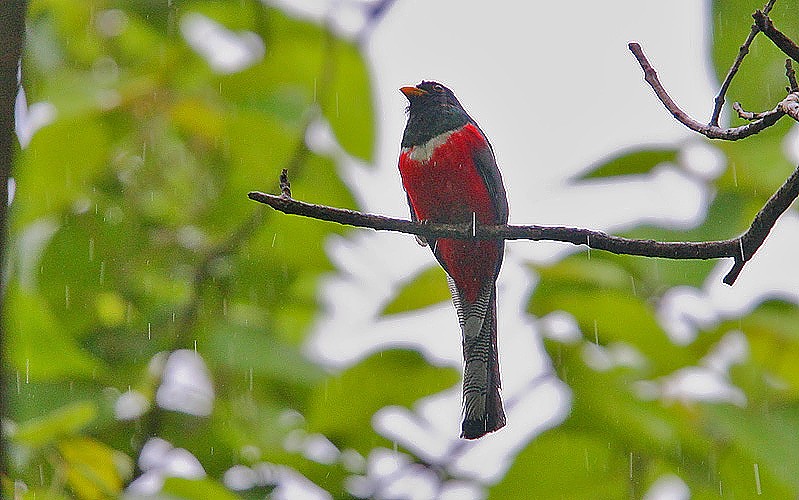Elegant Trogon
A species of Neotropical Trogons Scientific name : Trogon elegans Genus : Neotropical Trogons
Elegant Trogon, A species of Neotropical Trogons
Botanical name: Trogon elegans
Genus: Neotropical Trogons
Content
Description General Info
 Photo By Steve Garvie , used under CC-BY-SA-2.0 /Cropped and compressed from original
Photo By Steve Garvie , used under CC-BY-SA-2.0 /Cropped and compressed from original Description
This species is 28–30 centimetres (11–12 in) long and weighs 60–78 grams (2.1–2.8 oz) (average 68 grams (2.4 oz)). Like other trogons, elegant trogons have distinctive male and female plumages (sexual dimorphism), with soft feathers. Both sexes have a white undertail with fine horizontal black barring. The undertail also has large white tips spaced evenly ending in a black terminal band. Both have a yellow bill, orange-red undertail coverts and lower belly, and a white horizontal breast stripe. The male elegant trogon has a metallic deep green head, upper breast and back, black face and throat, and red-orange lower breast and belly. He shows grey upperwing coverts. The female has a metallic bronze head, upper breast, back, upper tail and upperwing coverts. She shows a dull white upper belly, and a small white vertical stripe behind the eye. The usual call is a croaking "co-ah co-ah co-ah". The trogon will also include some chattering notes. The elegant trogon is listed as endangered in the state of New Mexico. It prefers to live in conditions that would favor the presence of pineoak woodlands and local water making it particularly susceptible to disturbance. 
Size
28-32 cm (11-12.5 in)
Nest Placement
Tree
Clutch Size
2 - 4 eggs
Number of Broods
17 - 21 days
Nestling Period
34 - 40 days
Feeding Habits
Elegant Trogon are primarily omnivorous, with a diet rich in both insects, including grasshoppers and caterpillars, and various fruits like cherries, grapes, and figs. During breeding, insect consumption increases, particularly for offspring nourishment. Elegant Trogon forage in oaks and fruiting plants, with a significant portion of their diet being animal matter.
Habitat
Elegant Trogon typically inhabits mountain forests and is often associated with pine-oak and sycamore canyons, thriving at altitudes up to 6,200 feet in certain regions like Guatemala. These birds prefer areas rich in sycamore, pine, oak, and, to a lesser extent, juniper, cottonwood, Douglas-fir, and mesquite. In Arizona, elegant Trogon is primarily found in forested mountain canyons and chooses nesting sites predominantly in sycamore trees, but occasionally in oaks as well.
Nest Behavior
Elegant Trogon cannot create their own cavities and often reuse nests from previous years. Nesting involves laying eggs directly on the floor of the chosen cavity, and both parents participate in the care of eggs and young.
Nest Characteristics
Elegant Trogon typically nest in pre-existing cavities along streams, utilizing holes made by woodpeckers in live or dead trees, with a preference for large sycamores. The nest is usually bare, without construction materials, containing only the eggs on the cavity floor.
Dite type
Omnivorous
General Info
Feeding Habits
Bird food type
Sounds
Song
Recording location: Mexico
Song
Recording location: Mexico
Behavior
Elegant Trogon demonstrate distinct foraging behaviors within the lower forest canopy, remaining nearly stationary as they survey for prey with slight head movements. They exhibit sudden bursts of flight to capture unsuspecting prey detected on foliage or midair. Communication among elegant Trogon is vocal, encompassing courtship to offspring feeding. Males conspicuously advertise presence with loud calls from perches, often near nesting sites, and display by flaunting their vibrant chest plumage and engaging in tail flicks to court females. Agonistic interactions involve males inflating their chests and bill snapping, especially in territorial disputes. Their monogamous bond endures beyond the fledging of their young, with females actively defending their progeny from various predators. Elegant Trogon share their habitats with diverse avian species, indicating a complex ecological interaction.
Species Status
Not globally threatened.
Scientific Classification
Phylum
Chordates Class
Birds Order
Trogons Family
Trogons and quetzals Genus
Neotropical Trogons Species
Elegant Trogon